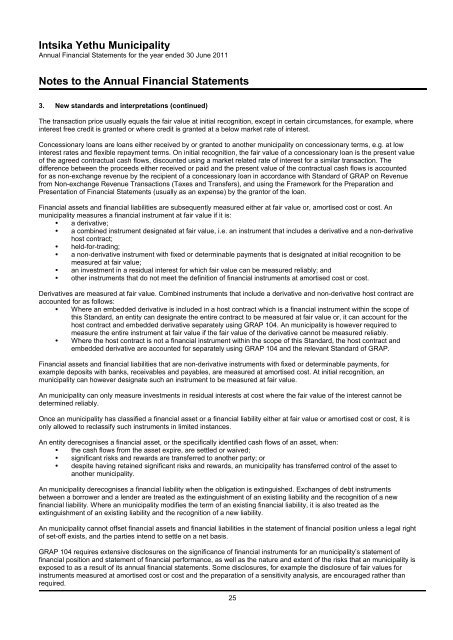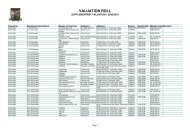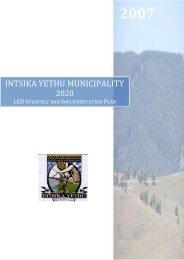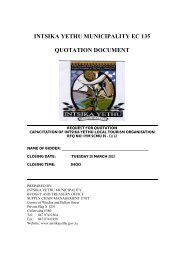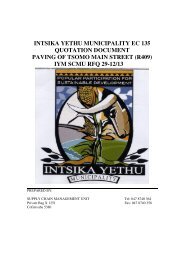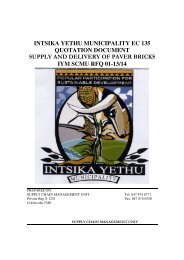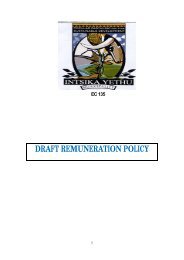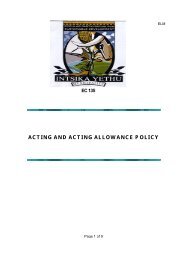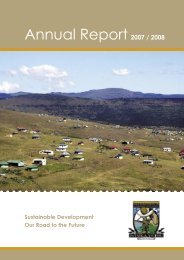annual report 2010 - 2011 - Intsika Yethu Municipality
annual report 2010 - 2011 - Intsika Yethu Municipality
annual report 2010 - 2011 - Intsika Yethu Municipality
Create successful ePaper yourself
Turn your PDF publications into a flip-book with our unique Google optimized e-Paper software.
<strong>Intsika</strong> <strong>Yethu</strong> <strong>Municipality</strong><br />
Annual Financial Statements for the year ended 30 June <strong>2011</strong><br />
Notes to the Annual Financial Statements<br />
3. New standards and interpretations (continued)<br />
The transaction price usually equals the fair value at initial recognition, except in certain circumstances, for example, where<br />
interest free credit is granted or where credit is granted at a below market rate of interest.<br />
Concessionary loans are loans either received by or granted to another municipality on concessionary terms, e.g. at low<br />
interest rates and flexible repayment terms. On initial recognition, the fair value of a concessionary loan is the present value<br />
of the agreed contractual cash flows, discounted using a market related rate of interest for a similar transaction. The<br />
difference between the proceeds either received or paid and the present value of the contractual cash flows is accounted<br />
for as non-exchange revenue by the recipient of a concessionary loan in accordance with Standard of GRAP on Revenue<br />
from Non-exchange Revenue Transactions (Taxes and Transfers), and using the Framework for the Preparation and<br />
Presentation of Financial Statements (usually as an expense) by the grantor of the loan.<br />
Financial assets and financial liabilities are subsequently measured either at fair value or, amortised cost or cost. An<br />
municipality measures a financial instrument at fair value if it is:<br />
a derivative;<br />
a combined instrument designated at fair value, i.e. an instrument that includes a derivative and a non-derivative<br />
host contract;<br />
held-for-trading;<br />
a non-derivative instrument with fixed or determinable payments that is designated at initial recognition to be<br />
measured at fair value;<br />
an investment in a residual interest for which fair value can be measured reliably; and<br />
other instruments that do not meet the definition of financial instruments at amortised cost or cost.<br />
Derivatives are measured at fair value. Combined instruments that include a derivative and non-derivative host contract are<br />
accounted for as follows:<br />
Where an embedded derivative is included in a host contract which is a financial instrument within the scope of<br />
this Standard, an entity can designate the entire contract to be measured at fair value or, it can account for the<br />
host contract and embedded derivative separately using GRAP 104. An municipality is however required to<br />
measure the entire instrument at fair value if the fair value of the derivative cannot be measured reliably.<br />
Where the host contract is not a financial instrument within the scope of this Standard, the host contract and<br />
embedded derivative are accounted for separately using GRAP 104 and the relevant Standard of GRAP.<br />
Financial assets and financial liabilities that are non-derivative instruments with fixed or determinable payments, for<br />
example deposits with banks, receivables and payables, are measured at amortised cost. At initial recognition, an<br />
municipality can however designate such an instrument to be measured at fair value.<br />
An municipality can only measure investments in residual interests at cost where the fair value of the interest cannot be<br />
determined reliably.<br />
Once an municipality has classified a financial asset or a financial liability either at fair value or amortised cost or cost, it is<br />
only allowed to reclassify such instruments in limited instances.<br />
An entity derecognises a financial asset, or the specifically identified cash flows of an asset, when:<br />
the cash flows from the asset expire, are settled or waived;<br />
significant risks and rewards are transferred to another party; or<br />
despite having retained significant risks and rewards, an municipality has transferred control of the asset to<br />
another municipality.<br />
An municipality derecognises a financial liability when the obligation is extinguished. Exchanges of debt instruments<br />
between a borrower and a lender are treated as the extinguishment of an existing liability and the recognition of a new<br />
financial liability. Where an municipality modifies the term of an existing financial liability, it is also treated as the<br />
extinguishment of an existing liability and the recognition of a new liability.<br />
An municipality cannot offset financial assets and financial liabilities in the statement of financial position unless a legal right<br />
of set-off exists, and the parties intend to settle on a net basis.<br />
GRAP 104 requires extensive disclosures on the significance of financial instruments for an municipality’s statement of<br />
financial position and statement of financial performance, as well as the nature and extent of the risks that an municipality is<br />
exposed to as a result of its <strong>annual</strong> financial statements. Some disclosures, for example the disclosure of fair values for<br />
instruments measured at amortised cost or cost and the preparation of a sensitivity analysis, are encouraged rather than<br />
required.<br />
25


